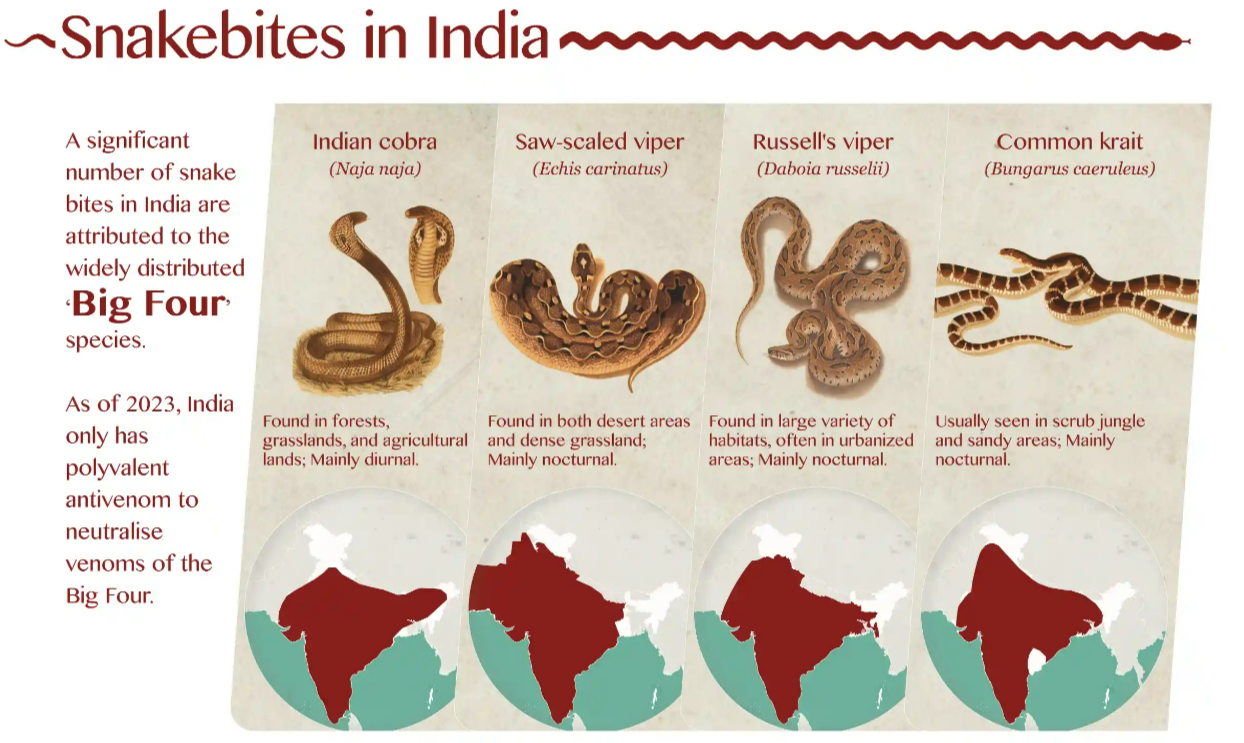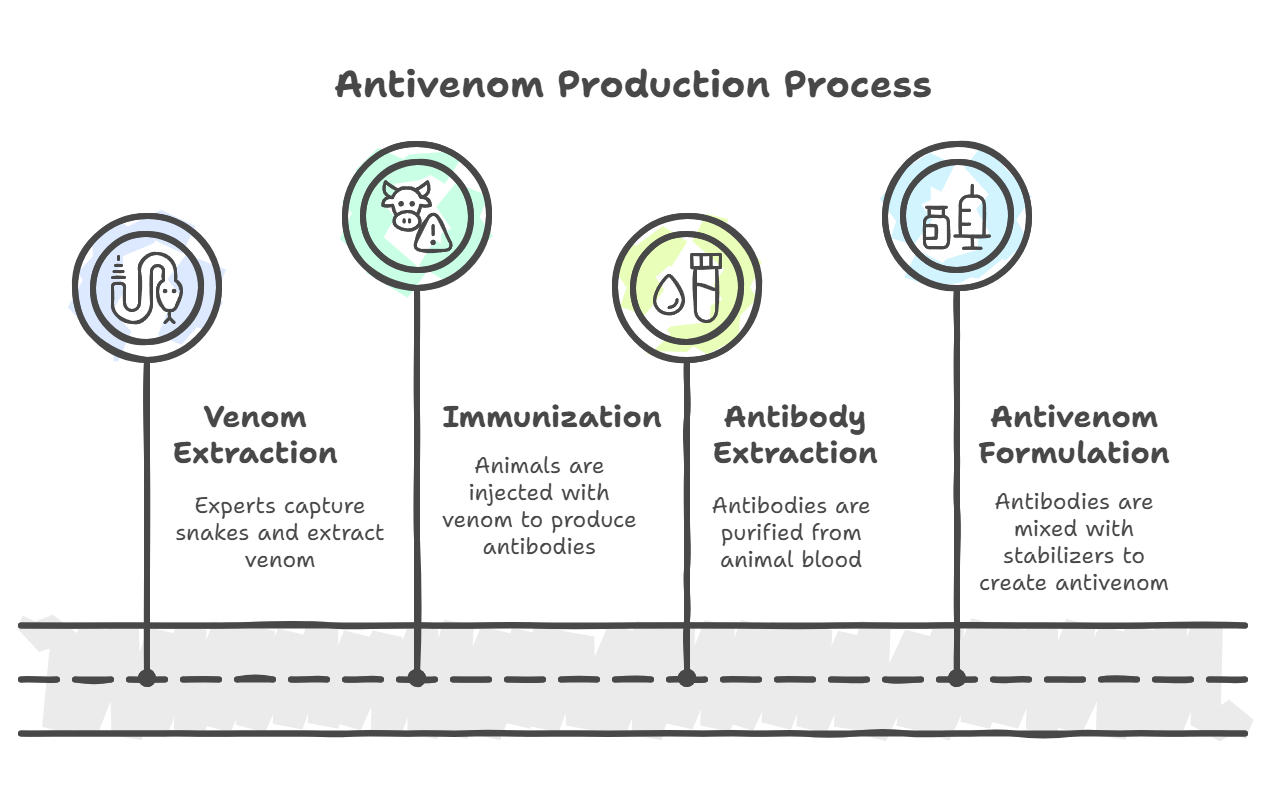Social Issues
Snakebites and Antivenom in India
- 30 Jan 2025
- 8 min read
For Prelims: Snakebite envenoming, Indian cobra, common krait, Russell’s viper, Saw-scaled viper, neglected tropical disease
For Mains: Challenges Related to Snakebites in India, Antivenom Production, Challenges and its availability in India
Why in News?
India accounts for nearly half of global snakebite deaths, with around 58,000 fatalities annually.
- Despite being the largest producer and consumer of antivenoms, challenges like delayed access, poor rural healthcare, and infrastructure gaps hinder effective treatment.
What are the Key Facts Regarding Snakebite?
- Global Scenario:
- According to WHO, 5.4 million people are bitten by snakes annually, with 1.8 to 2.7 million cases resulting in venom exposure.
- Snake bites cause around 81,410 to 137,880 deaths annually, and many more people suffer from amputations and permanent disabilities due to snake bites.
- The WHO has classified snakebite envenoming (poisoning from snake bites) as a neglected tropical disease of high priority.
- In India:
- Diversity of Venomous Snakes: India hosts over 300 snake species, with more than 60 being venomous.
- The Big Four (Indian cobra, common krait, Russell’s viper, and saw-scaled viper) are responsible for most snakebite deaths in India.
- Snakebite Mortality and Disability: A study estimates that between 2001 and 2014, India witnessed approximately 1.2 million deaths and 3.6 million cases of permanent disabilities due to snakebites.
- One in 250 Indians is at risk of dying from a snakebite before 70.
- Vulnerable Populations: Rural communities, especially agricultural workers, are at higher risk, particularly during the monsoon, with inadequate healthcare worsening outcomes.
- Urban Risks: Rapid urbanisation, poor waste management, and urban flooding have increased snake-human encounters, raising risks even in cities.
- Diversity of Venomous Snakes: India hosts over 300 snake species, with more than 60 being venomous.
What are Antivenoms?
- Snake Venom: It is a potent mixture of toxic proteins that causes severe damage to the human body.
- Haemotoxins destroy blood cells and disrupt clotting.
- Neurotoxins block nerve signals and paralyse.
- Cytotoxins dissolve tissue at the bite site.
- Antivenoms: Antivenoms or antivenins are life-saving medicines used to treat snake bites.
- Antivenoms work by binding to the venom toxins, neutralizing them, and allowing the body's immune system to safely eliminate them over time.
- Polyvalent Antivenoms in India are made from the venom of the "Big Four" but do not cover other venomous species like the king cobra and pit vipers.
- Production of Antivenom:
- Antivenom production involves extracting venom from snakes, immunizing animals like horses or sheep to produce antibodies, and then extracting and purifying these antibodies from the animal’s blood to formulate the antivenom.
- Production In India:
- Several companies produce antivenoms. The Irula tribe of Tamil Nadu plays a vital role in venom extraction (supplying nearly 80% of the venom).
Note:
- Snakes are protected under various schedules of the Wildlife Protection Act, 1972, and capturing, killing, or milking venomous species is prohibited in India.
- The Chief Wildlife Warden may grant a permit to hunt wild animals, including for snake venom extraction for life-saving drugs, with written approval.
- However, for Schedule I animals, prior Central Government permission is required.
What are the Challenges Accessing Antivenoms in India?
- Geographical Barriers: Remote areas lack proximity to healthcare facilities equipped with antivenom, hindering timely treatment.
- Cultural and Social Factors: Superstitions and reliance on traditional practices in rural areas often delay seeking medical care, worsening outcomes.
- Economic Constraints: The high production cost of antivenoms limits access, especially for economically disadvantaged communities.
- Logistical Issues: Insufficient cold storage and inadequate infrastructure in rural areas result in degraded antivenom quality, reducing its efficacy.
What are the Emerging Solutions and Innovations in Antivenoms?
- National Action Plan for Prevention and Control of Snakebite Envenoming (NAP-SE): NAP-SE aims to halve the number of deaths and disabilities caused by snakebites by 2030.
- Synthetic Antivenoms: Recombinant DNA technology and AI-designed proteins, as demonstrated by 2024 Nobel laureate David Baker’s team, offer safer and more effective alternatives to traditional antivenoms.
- Region-Specific Antivenoms: IISc Bengaluru researchers are developing antivenoms tailored to specific snake species and regional venom variations.
- Rapid Diagnostic Tools: Portable venom-detection kits can guide accurate and timely administration of antivenoms, improving patient outcomes.
- Public Education Campaigns: Raising awareness about snakebite prevention and timely medical intervention can significantly reduce fatalities.
|
Drishti Mains Question: Discuss the challenges contributing to high snakebite mortality in India and suggest measures to reduce fatalities. |
UPSC Civil Services Examination, Previous Year Questions (PYQs)
Prelims
Q 1. Consider the following statements: (2019)
- Some species of turtles are herbivores.
- Some species of fish are herbivores.
- Some species of marine mammals are herbivores.
- Some species of snakes are viviparous.
Which of the statements given above are correct?
(a) 1 and 3 only
(b) 2, 3, and 4 only
(c) 2 and 4 only
(d) 1, 2, 3 and 4
Ans: (d)
Q 2. King Cobra is the only snake that makes its own nest. Why does it make its nest? (2010)
(a) It is a snake-eater and the nest helps attract other snakes
(b) It is a viviparous snake and needs a nest to give birth to its offspring
(c) It is an oviparous snake and lays its eggs in the nest and guards the nest until they are hatched
(d) It is a large, cold-blooded animal and needs a nest to hibernate in the cold season
Ans: (c )
Q 3. For which one of the following snakes is the diet mainly composed of other snakes? (2008)
(a) Krait
(b) Russell’s viper
(c) Rattlesnake
(d) King Cobra
Ans: (d)






